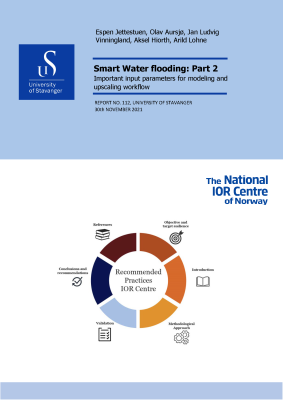Smart Water flooding: Part 2: Important input parameters for modeling and upscaling workflow
Keywords:
The National IOR Centre of Norway, smart water flooding, simulation toolsSynopsis
This document presents some guidelines on how to conduct numerical investigations of the physicochemical effects of Smart Water flooding on different length scales.
The National IOR Centre of Norway (NIORC) has developed several simulation tools. The objective of this report is to describe how three NIORC-developed simulation tools BADChIMP, IORCoreSim, and IORSim, can be used to investigate Smart Water effects on different length scales. We present which input parameters are needed by the simulation tools, and we discuss which processes these tools are suited to study.
When working with different length scales, one of the challenges is how to upscale results obtained from smaller scales, i.e., pore and core scale experiments or simulations, to the field scale. Here, three relevant questions are: 1) how far do the Smart Water effects propagate into a reservoir? 2) What is the effect of reservoir temperature on Smart Water behavior? 3) How is the oil release, observed on core scale, related to the oil production from a field?
This document targets research scientists planning to perform either pore scale simulations, core scale simulations, or field scale simulations for Smart Water studies.
The technical level of the document is targeting an industry engineer.
References
https://doi.org/10.1016/j.jcp.2016.12.014
Helgeson, H. C., Kirkham, D. H., & Flowers, G. C. (1981). Theoretical prediction of the thermodynamic behavior of aqueous electrolytes by high pressures and temperatures; IV, Calculation of activity coefficients, osmotic coefficients, and apparent molal and standard and relative partial molal properties to 600 d. American journal of science, 281, 1249-1516.
https://doi.org/10.2475/ajs.281.10.1249
Hiorth, A., Cathles, L., & Madland, M. (2010). The impact of pore water chemistry on carbonate surface charge and oil wettability. Transport in porous media, 85, 1-21.
https://doi.org/10.1007/s11242-010-9543-6
Hiorth, A., Jettestuen, E., Cathles, L. M., & Madland, M. V. (2013). Precipitation, dissolution, and ion exchange processes coupled with a lattice Boltzmann advection diffusion solver. Geochimica et Cosmochimica Acta, 104, 99-110.
https://doi.org/10.1016/j.gca.2012.11.019
Mamonov, A., Strand, S., Puntervold, T., & Piñerez Torrijos, I. D. (2021). Smart Water flooding: Part 1 - Laboratory workflow for screening EOR potential. Stavanger: The National IOR Centre of Norway.
https://doi.org/10.31265/usps.199
Neuville, A., Renaud, L., Luu, T. T., Minde, M. W., Jettestuen, E., Vinningland, J. L., . . . Dysthe, D. K. (2017). Xurography for microfluidics on a reactive solid. Lab on a Chip, 293-303.
https://doi.org/10.1039/C6LC01253A
Pedersen, J., Jettestuen, E., Madland, M. V., Hildebrand-Habel, T., Korsnes, R. I., Vinningland, J. L., & Hiorth, A. (2016). A dissolution model that accounts for coverage of mineral surfaces by precipitation in core floods. Advances in Water Resources, 87, 68-79. doi:10.1016/j.advwatres.2015.11.010
https://doi.org/10.1016/j.advwatres.2015.11.010
Puntervold, T., Strand, S., Ellous, R., & Austad, T. (2015). Modified seawater as a smart EOR fluid in chalk. Journal of Petroleum Science and Engineeing.
https://doi.org/10.1016/j.petrol.2015.06.034
Sandvik, S. (2018). Simulation of oil recovery by wettability alteration - interpretation of Smart water imbibition experiments at reservoir conditions. Master's thesis. UiS.
Stavland, A., Jonsbråten, H. C., Vikane, O., Skrettingland, K., & Fischer, H. (2011). In-depth water diversion using sodium silicate on snorre-factors controlling in-depth placement. SPE European Formation Damage Conference. OnePetro.
https://doi.org/10.2118/143836-MS
Vinningland, J. L., Jettestuen, E., Aursjø, O., Madland, M. V., & Hiorth, A. (2017). Mineral Dissolution and Precipitation Rate Laws Predicted from Reactive Pore Scale Simulations. IOR 2017-19th European Symposium on Improved Oil Recovery (pp. 1-15). European Association of Geoscientists & Engineers.
https://doi.org/10.3997/2214-4609.201701792
Webb, K. J., Black, C. J., & Tjetland, G. (2005). A Laboratory Study Investigating Methods for Improving Oil Recovery in Carbonates. International Petroleum Technology Conference. Doha, Qatar
https://doi.org/10.2523/10506-MS


